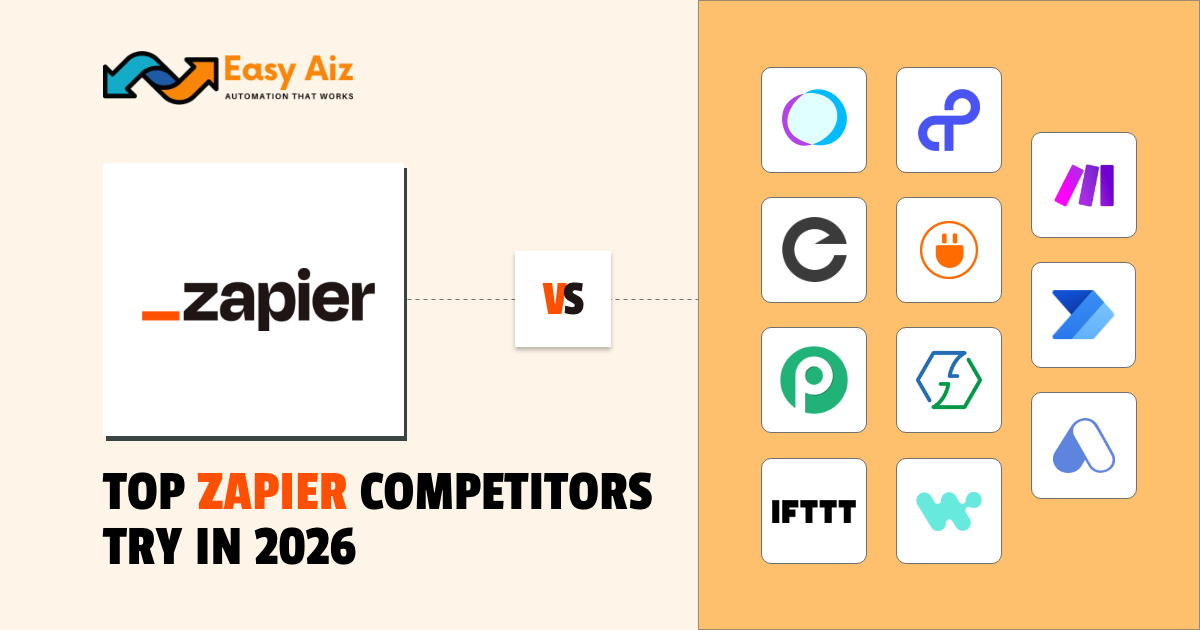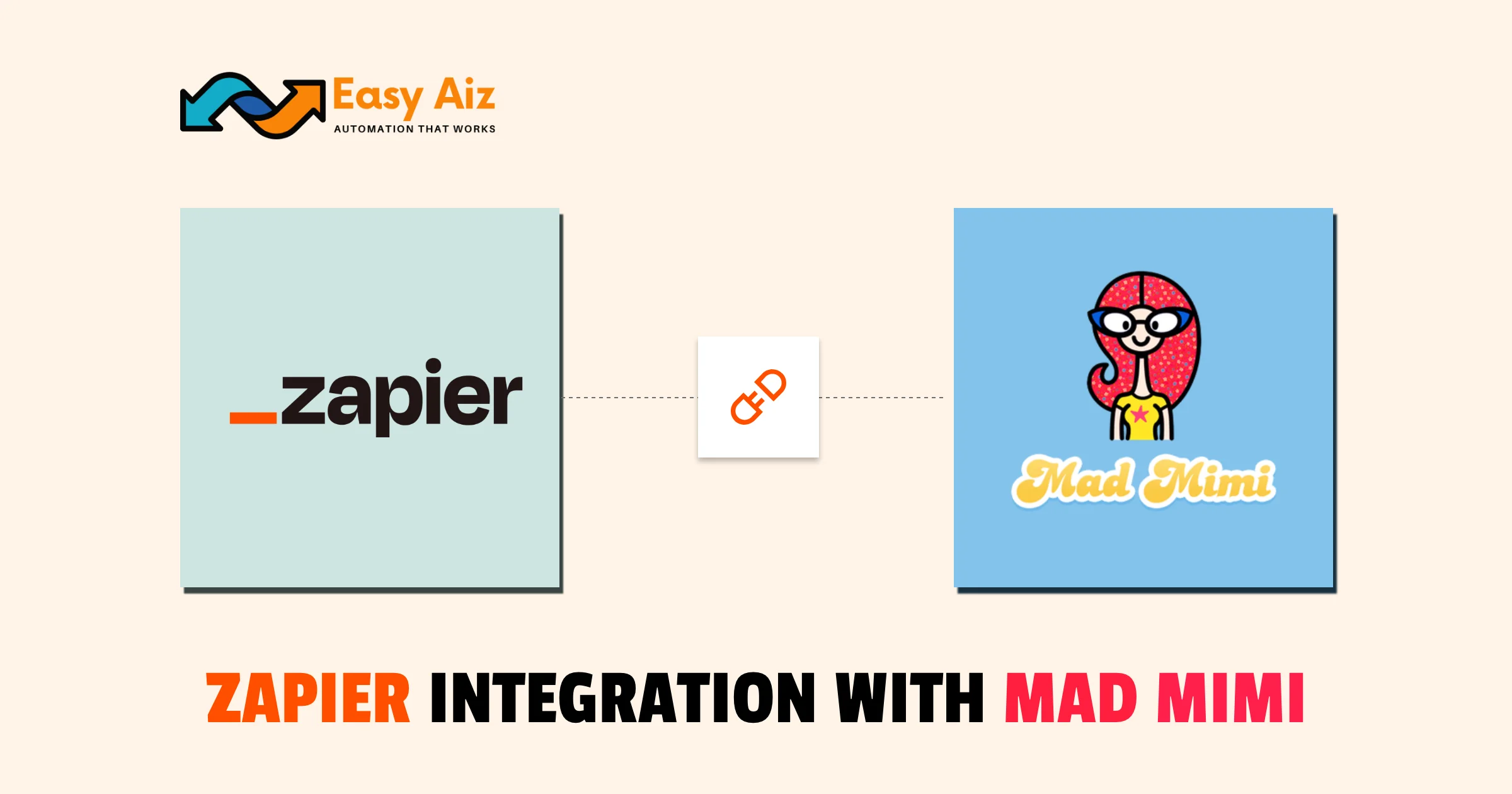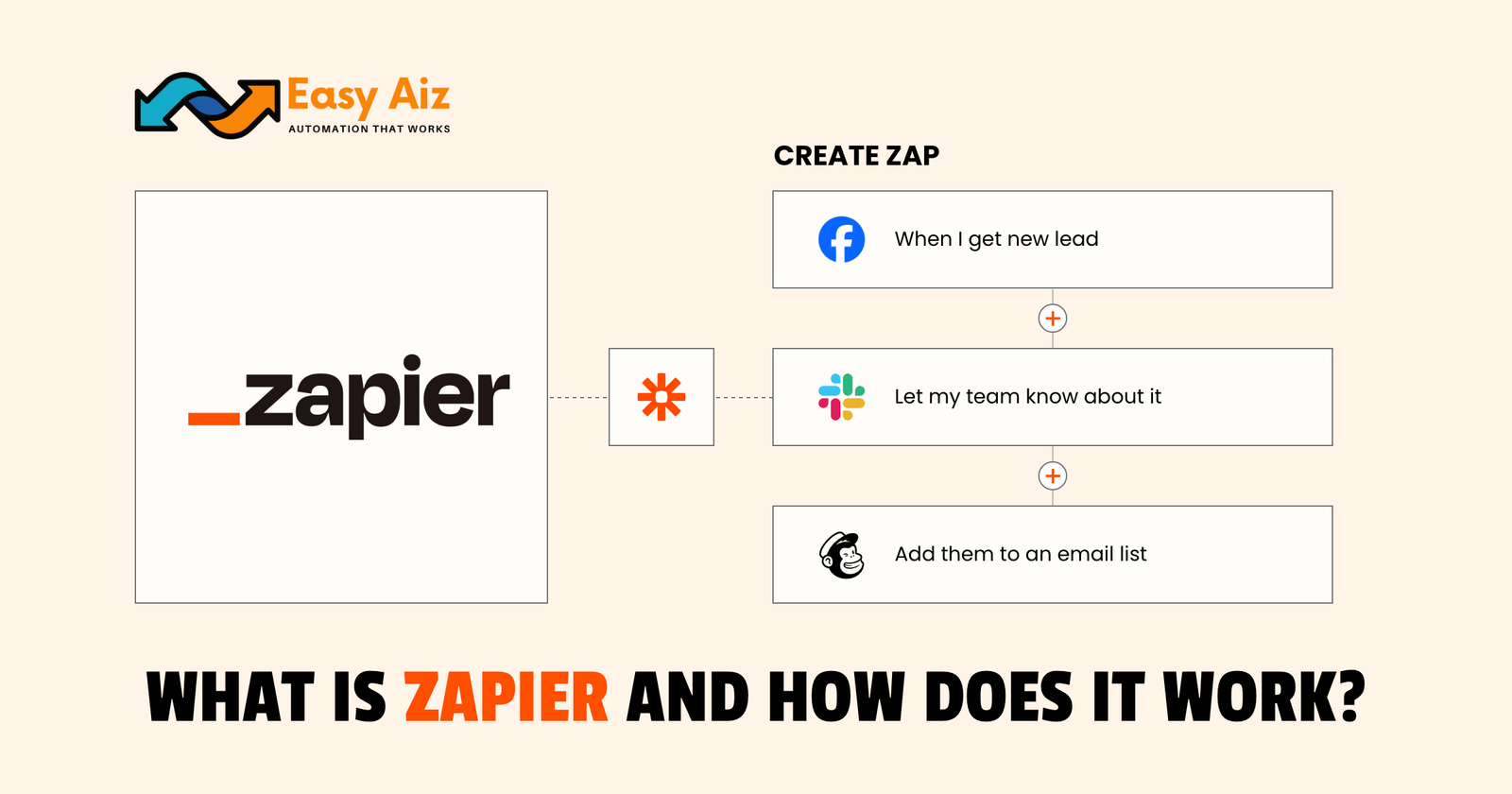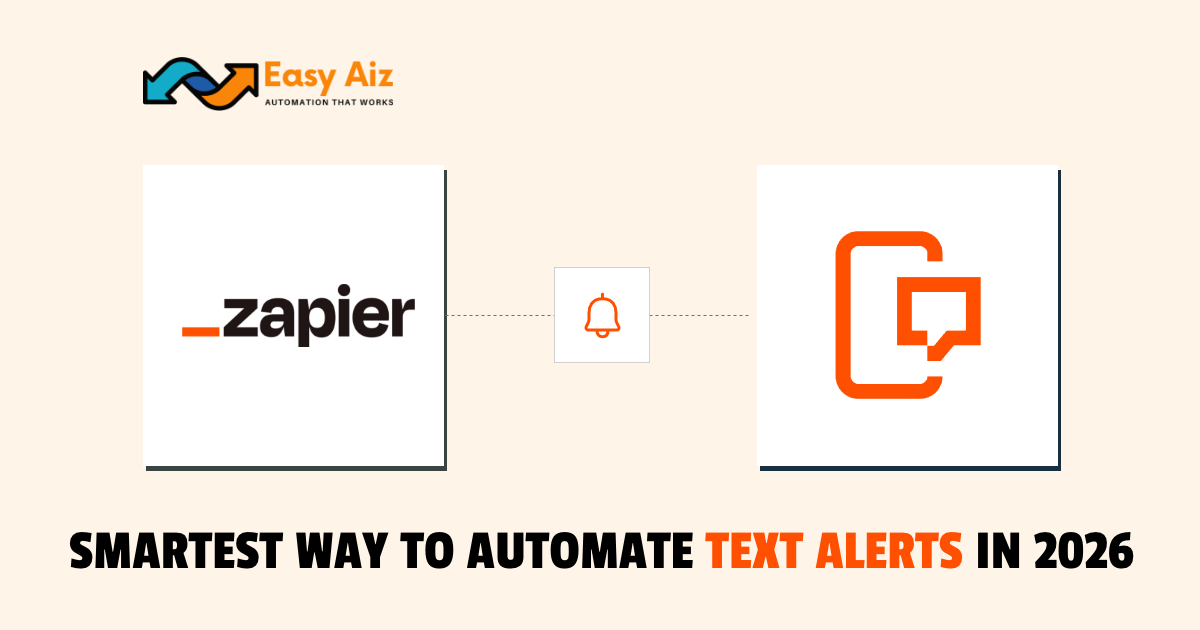Table of Contents
Zapier Vs MuleSoft Complete Comparison with Explanation
Zapier and Mulesoft are both one of the best automation tools if you want to manage your daily tasks but now the scene is that which is more suitable for your business. As Automation Experts we know that every business is different from other businesses because of this every business’s needs are different from others but everyone’s purpose is the same they want to boost their business and save time to focus on their main goals.
Now let’s start the comparison of Zapier and MuleSoft.
How We Compare?
If comparison is not fair it will be a time waste. Easy Aiz compare Zapier and MuleSoft on these bases.
- Based on their features
- Integrations
- Rating and reviews
- Customers and users
- Pricing
Zapier
Zapier is a simple automation tool that works with 7000+ apps. It is most used for small and medium-sized businesses and it is very easy to use even non-technical users can make automation through zapier. Zapier works on Zaps which are simply based on triggers and actions. Zapier is not able to import existing data but it can connect thousands of apps in a few clicks. It also supports thousands of pre-built templates for its users that can help you make automation without any effort. Zapier has 2 Million+ customers.
Zapier Characteristics
Large App Library: Zapier is known for its large app library that is more than 7000+ apps. Almost all famous business apps are available in Zapier and you can automate them.
Easy to Use: Another thing in Zapier that makes it more useful for anyone is its easy user interface and anyone can make automation with the help of Zapier without any extra knowledge.
Automate Repetitive Tasks: The core functionality of Zapier is the Automation of repetitive tasks, so you don’t need to do it manually every time.
Move Data: Zapier automatically moves data from one app to another app.
Zapier Support
Zapier has a very dedicated support team that helps their customers troubleshoot and automate workflows with real humans. They offer their support 24 hours a day and five days a week and 12 hours a day on weekends. Zapier has a help center that helps users find the answers to their questions, a community for discussions about their problems, and also It has Zapier Learn to help you learn about Zapier.
Zapier Pricing
Zapier offers a free plan for always but with limited features and its pricing plans are task based. Zapier has a total of four pricing plans.
Free Plan: The free plan offers 100 tasks for a month but with two-step zaps.
Professional Plan: It starts from $19.99 per month with 750 tasks, Multi-Step Zap, Unlimited premium apps, and webhooks.
Team Plan: Costs $69 per month with 2k tasks, Unlimited users, shared workspace, shared app connections, and Premier support.
Enterprise: For pricing details, you can contact with Zapier sales team. In this plan, you will get Advanced admin permissions and app controls, Annual task limits, Observability, SAML SSO, and Designed technical support.
Zapier Pros & Cons
Pros
- No-Code automation tool.
- Create Complex Workflows.
- Share data without storing it locally.
- Keep data secure.
- Allow to Connect with other APIs.
Cons
- Limited features when connecting apps.
- Costly because its price depends on task.
- Not available any feature to test Zap without actually sending data.
MuleSoft
MuleSoft was acquired by Salesforce in 2018. MuleSoft launches many tools powered by Salesforce Einstein AI. Simplifies the difficulty of managing servers, logs, and infrastructure. This ease of use extends to non-IT users, who receive data-mapping recommendations without needing extensive technical knowledge. At the same time, the Anypoint platform continues to allow IT teams with tools to monitor, govern, and secure APIs completely. MuleSoft also provides pre-built templates and we know them by the name Accelators. MuleSoft has 12000+ customers.
Characteristics of MuleSoft
Speed: MuleSoft can connect data across the cloud, and its products are very fast. There are a lot of internet-connected devices that can send, receive, and collect data across the cloud without slowing down your business speed.
Scalable: MuleSoft provides you with scalability that helps you to expand your capabilities when your needs grow.
Flexible: It provides MuleSofts’s open-source Integration hub that helps you to connect any device or application.
Security: MuleSoft’s security is very strict to protect any sensitive data.
MuleSoft Support
MuleSoft offers large support since it is an enterprise-grade tool. It also has a forum for its users to communicate with each other. Like Zapier, MuleSoft has a Help Centre to give answers about their customer problems.
MuleSoft Pricing
There are three tier offers MuleSoft Anypoint Integration Starter, Anypoint Integration Advanced, and API Management Solution. MuleSOft Anypoint Platform offers a 30-day free trial.
MuleSoft Pros & Cons
Pros
- Large Community.
- Integrate any application with MuleSoft’s open source integration hub.
- Multiple deployment options.
- Fully Customizable.
- Easily handle large data.
Cons
- Coding Required.
- Expensive.
- Complex User interface.
Zapier and MuleSoft Features Comparison Table
| Features | MuleSoft | Zapier |
|---|---|---|
| API Developer Portal | Good | N/A |
| RBAC | Ok | Ok |
| Automated Integration flow testing | OK | N/A |
| Suitable for integration specialists | Good | Good |
| Suitable for Line business users | Ok | Good |
| Integration Templates | Good | Good |
| Data redundancies detection | Ok | Good |
| Suitable for IT Users | Good | Ok |
| Administration Run time | Ok | Ok |
| Version Control and Provisioning | Good | Good |
| Development Workflow Experience | Ok | OK |
| File based Interaction | Ok | N/A |
| Ability to enrich messages | Ok | Good |
| Ability to route the message | Ok | Ok |
| Ability to inspect messages | Ok | Bad |
| Ability to validate message | Ok | Bad |
| Data Management | Ok | Good |
| Data Integration | Ok | Good |
| Integration Marketplace | Good | Good |
| API Integration | Good | Good |
| Pricing for more messages | N/A | Good |
MuleSoft vs Zapier Reviews and Scores
| Company | MuleSoft | Zapier |
| G2 | 4.5 out of 5 | 4.5 out of 5 |
| Capterra | 4.4 out of 5 | 4.7 out of 5 |
| Trust Radius | 8.2 out of 10 | 8.9 out of 10 |
| GetApp | 4.4 out of 5 | 4.7 out of 5 |
| Trustpilot | N/A | 1.6 out of 5 |
| Software Suggest | 5 out of 5 | 4.6 out of 5 |
| Gartner | 4.4 out of 5 | 4.8 out of 5 |
| crozdesk | 90 out of 100 | 92 out of 100 |
| Comparably | 4.1 out of 5 | 4.5 out of 5 |
Difference between Zapier and MuleSoft
Uses:
MuleSoft deals with large companies and
Zapier is best for small and medium size businesses. MuleSoft is mostly famous in Automotive industries and communication equipment. Zapier is very beneficial for those who offer professional services. MuleSoft and Zapier both mostly clients are United States and UnitedKingdom based but Zapier also used in Canada and Australia.
Concept:
Both platforms have large differences in their basic concepts because Zapier works on Connecting apps and workflow automation directly while MuleSoft is an API-led platform due to API connectivity MuleSoft offers more integration than Zapier. Because of more integration large companies choose MuleSoft for data transformation, message routing abilities, and as well as hosting
There are quite differences between these tools but both tools are enough to increase productivity and boost your business.
Noticeable Difference:
There is no doubt that Zapier has more features at a very low price than MuleSoft. Overall MuleSoft works with high paying clients at an enterprise level and it is not designed for small businesses. MuleSoft needs a technically experienced Java developer to handle it on the other hand Zapier is very easy to use but for some complex functionality, you need a Zapier Solution Partner to handle it.
Final Decision:
Every tool has its functionalities and weaknesses we can’t say that this tool is better than others. In this comparison we can say that Zapier has more functionalities than MuleSoft and Zapier is best for small and medium sized businesses even for Large level you can use Zapier but MuleSoft is more suitable for large enterprise level businesses for small businesses MuleSoft would be complex and costly. Zapier is more rated than MuleSoft which shows that more people like Zapier than MuleSoft. You can use both tools as per requirements both tools are best to boost and automate your business.
Table of Contents
Get started with Easy Aiz
Have any project in mind? Book a free call now to automate your Project !!
More Blogs
Explore top 11 closest Zapier competitors- each offering a unique set of features and facilities.
How to Set Up Zapier Integration with Mad Mimi and Outgrow Zohaib Ali10/07/2025 Table of …
Explore some of the best email marketing softwares in 2025 along with their key features, pros, cons and pricing plans.
SMS by Zapier: The Smartest Way to Automate Your Text Alerts in 2026 Ayan Waraich …





